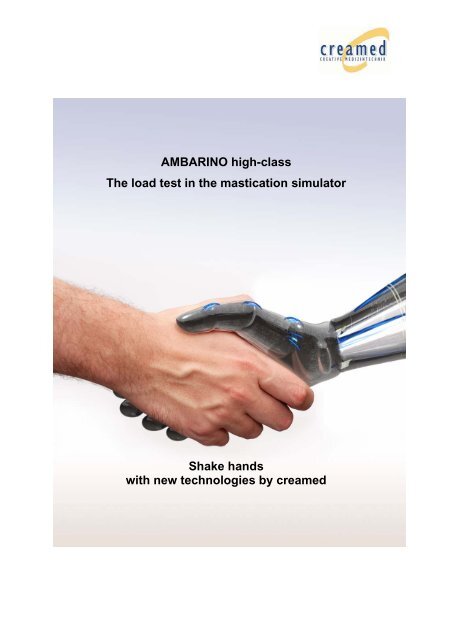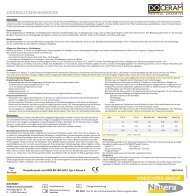AMBARINO high-class The load test in the ... - Creamed.de
AMBARINO high-class The load test in the ... - Creamed.de
AMBARINO high-class The load test in the ... - Creamed.de
You also want an ePaper? Increase the reach of your titles
YUMPU automatically turns print PDFs into web optimized ePapers that Google loves.
<strong>AMBARINO</strong> <strong>high</strong>-<strong>class</strong><br />
<strong>The</strong> <strong>load</strong> <strong>test</strong> <strong>in</strong> <strong>the</strong> mastication simulator<br />
Shake hands<br />
with new technologies by creamed
Documentation: "creamed" anatomically milled bridges.<br />
<strong>AMBARINO</strong> <strong>high</strong>-<strong>class</strong> blanc, supplied with 10 milled three-unit bridges<br />
Front<br />
<strong>The</strong> lower portions of <strong>the</strong> posts cast <strong>in</strong> CoCr were coated with a soft elastic film<br />
Film 1,5 mm<br />
Defect<br />
Back
Prior to attachment, <strong>the</strong> posts adapted for <strong>the</strong> purpose were sand-blasted at 110µm/2 bar<br />
and <strong>the</strong>n <strong>de</strong>greased. After polish<strong>in</strong>g and steam-clean<strong>in</strong>g, <strong>the</strong> <strong>in</strong>ternal walls of <strong>the</strong> crowns of<br />
<strong>the</strong> res<strong>in</strong> bridges only required thorough clean<strong>in</strong>g with acetone.<br />
<strong>The</strong> bridges 1-5 were connected us<strong>in</strong>g „„<strong>AMBARINO</strong> Hard Flow“/clear # 2008005192<br />
Bridges 1-5<br />
<strong>The</strong> bridges 6-10 were attached us<strong>in</strong>g „PANAVIA F 2.0/TC“ A+B paste (# 00312A – 00171B)<br />
Bridges 6-10<br />
<strong>The</strong> follow<strong>in</strong>g <strong>de</strong>fect on bridge 5 and <strong>the</strong> cracks <strong>in</strong> <strong>the</strong> bridge unit (bridge 10) were<br />
documented here photographically prior to <strong>the</strong> start of <strong>the</strong> <strong>test</strong>:
Embedd<strong>in</strong>g of <strong>the</strong> 3-unit bridges <strong>in</strong> res<strong>in</strong> <strong>in</strong> <strong>the</strong> sample conta<strong>in</strong>ers. However, <strong>in</strong> <strong>the</strong> case of<br />
PEM-I, a hole (Ø 12 mm + Ø 10 mm) was first milled <strong>in</strong> <strong>the</strong> res<strong>in</strong> Blancs.<br />
<strong>The</strong> samples are <strong>in</strong>stalled <strong>in</strong> <strong>the</strong> mastication simulator and appropriately oriented towards <strong>the</strong><br />
antagonist spheres.<br />
<strong>The</strong> fully assembled mastication simulator <strong>in</strong> action:
Removal of <strong>the</strong> bridges after 1.2m mastication cycles on <strong>the</strong> 18 th November 2008, with<br />
subsequent photographic documentation:<br />
Bridge 1 Bridge 2<br />
Bridge 3 Bridge 4<br />
Bridge 5 Bridge 6
Figure legends for <strong>the</strong> REM images:<br />
1) Bridge no.: 4<br />
Bridge 7 Bridge 8<br />
Bridge 9 Bridge 10<br />
<strong>The</strong> cover sheet shows an overview of bridge no. 4 (Fig. 1) and an REM image of <strong>the</strong> bridge<br />
(Fig. 2) for improved orientation.<br />
We have documented a total of four contact po<strong>in</strong>ts <strong>in</strong> this case (Figs. 3 – 6). This bridge was<br />
also <strong>the</strong> only one <strong>in</strong> which hairl<strong>in</strong>e cracks were found along <strong>the</strong> length of its larger<br />
components (Figs. 7 – 9). <strong>The</strong>se were located <strong>in</strong> <strong>the</strong> left fissure next to <strong>the</strong> marg<strong>in</strong>al ridge of<br />
tooth number 6 and close to <strong>the</strong> dom<strong>in</strong>ant contact po<strong>in</strong>t on number 5. In contrast, no such<br />
fur<strong>the</strong>r hairl<strong>in</strong>e cracks were <strong>de</strong>tected on tooth 4 and on <strong>the</strong> distal region of <strong>the</strong> molar. It is not,<br />
however, possible to judge <strong>in</strong> retrospect whe<strong>the</strong>r <strong>the</strong>se hairl<strong>in</strong>e cracks occurred due to <strong>the</strong><br />
stresses <strong>in</strong> <strong>the</strong> mastication simulator or whe<strong>the</strong>r <strong>the</strong>y had occurred beforehand dur<strong>in</strong>g<br />
mechanical process<strong>in</strong>g. It is also of note that this tooth had <strong>the</strong> smoo<strong>the</strong>st surface.<br />
2) Bridge no.: 6<br />
<strong>The</strong> overview is <strong>de</strong>signed <strong>in</strong> <strong>the</strong> same way (Figs. 1 + 2). <strong>The</strong> three contact po<strong>in</strong>ts that were<br />
present were documented <strong>in</strong> <strong>the</strong> REM images Figs. 3 – 6 and <strong>the</strong>re were no abnormalities<br />
apart from an overall rougher surface.
3) Bridge no.: 10<br />
Once more, <strong>the</strong> overview (Figs. 1 + 2). <strong>The</strong> four contact po<strong>in</strong>ts that were present were<br />
documented <strong>in</strong> <strong>the</strong> REM images Figs. 4 – 7. <strong>The</strong> abnormal abrasion (Fig. 3) on <strong>the</strong> palat<strong>in</strong>e<br />
cusp of <strong>the</strong> bridge unit is not due to <strong>the</strong> antagonist sphere <strong>in</strong> <strong>the</strong> mastication simulator. <strong>The</strong><br />
palat<strong>in</strong>e cracks <strong>in</strong> this bridge that had been noted at <strong>the</strong> start have not wi<strong>de</strong>ned and are once<br />
more documented <strong>in</strong> a REM image <strong>in</strong> Fig. 8. This bridge also exhibits a rough surface.<br />
………………………………………………………………………………………………………….<br />
Summary:<br />
<strong>The</strong> <strong>load</strong> on <strong>the</strong> ten bridges ma<strong>de</strong> from <strong>the</strong> nanocomposite produced by <strong>the</strong> company<br />
"creamed" caused no <strong>in</strong>ci<strong>de</strong>nts.<br />
Follow<strong>in</strong>g <strong>the</strong> removal of all sample bridges, no cracks or o<strong>the</strong>r serious damage were<br />
<strong>de</strong>term<strong>in</strong>ed ei<strong>the</strong>r with <strong>the</strong> naked eye or un<strong>de</strong>r magnification. Even <strong>the</strong> exten<strong>de</strong>d microscopic<br />
assessment after 24 hours revealed no changes to <strong>the</strong> previous, positive result.<br />
A requested exam<strong>in</strong>ation and analysis of <strong>the</strong> contact po<strong>in</strong>ts created by <strong>the</strong> antagonist sphere<br />
revealed no significant wear or any cracks due to such wear on <strong>the</strong> three samples selected<br />
especially for this purpose (exception: microscopic cracks on bridge 4). Please refer to <strong>the</strong><br />
separate REM documentation with <strong>the</strong> associated figure legend provi<strong>de</strong>d above.<br />
Likewise, <strong>the</strong> <strong>de</strong>fects documented on bridges no. 5 and no. 10 at <strong>the</strong> start dur<strong>in</strong>g<br />
<strong>the</strong>rmocycl<strong>in</strong>g had not <strong>de</strong>teriorated or expan<strong>de</strong>d.<br />
Both composites used <strong>in</strong> this <strong>test</strong> were equal <strong>in</strong> quality to <strong>the</strong> naked eye.<br />
………………………………………………………………………………………………………….
<strong>AMBARINO</strong> <strong>high</strong>-<strong>class</strong><br />
Milled bridge after 1.2m cycles <strong>in</strong> mastication simulator<br />
Bridge 4<br />
Pos. Fig. 6<br />
15.6 : 1<br />
Fig. 7,8<br />
Pos. Fig.. 3<br />
Fig. 9<br />
Pos. Fig.. 5 Pos. Fig. 4<br />
2mm<br />
Fig. 2<br />
Fig. 1<br />
Macro photograph<br />
Overview<br />
Overview REM
61.1 : 1<br />
611 : 1<br />
611 : 1<br />
200µm<br />
20µm<br />
20µm<br />
Fig. 3<br />
Contact po<strong>in</strong>t 1<br />
Overview and sections
<strong>The</strong> huge challenge to a new material <strong>in</strong> pro<strong>the</strong>tic <strong>de</strong>ntistry<br />
<strong>AMBARINO</strong> <strong>high</strong>-<strong>class</strong><br />
<strong>The</strong> <strong>load</strong> <strong>test</strong> <strong>in</strong> <strong>the</strong> mastication simulator:<br />
1.2m <strong>load</strong> cycles at 70N / <strong>the</strong>rmocycles corresponds to <strong>the</strong> natural oral <strong>load</strong> due to mastication<br />
exerted over more than five years.<br />
Documentation on 10 three-unit bridges (14 crown – 15 bridge unit – 16 crown), fully anatomically<br />
milled from an <strong>AMBARINO</strong> <strong>high</strong>-<strong>class</strong> round blank of 18mm <strong>in</strong> thickness and of <strong>the</strong> colour A2,<br />
produced by <strong>the</strong> company "creamed", <strong>in</strong> <strong>the</strong> mastication simulator.<br />
<strong>The</strong> th<strong>in</strong>nest portions, at 0.2 – 0.3 mm, were located <strong>in</strong> <strong>the</strong> centre of <strong>the</strong> fissure and also occasionally<br />
<strong>in</strong> <strong>the</strong> cervical marg<strong>in</strong>s of <strong>the</strong> crowns.<br />
<strong>The</strong> milled bridges were extracted from <strong>the</strong> round blank, briefly processed, polished and numbered<br />
from 1-10.<br />
Dur<strong>in</strong>g extraction of bridge no. 5, a <strong>de</strong>fect occurred cervically <strong>in</strong> <strong>the</strong> mesio-buccal area on crown 14<br />
(photo, page 2, bottom left).<br />
Cracks can be seen on bridge no. 10, bridge unit 15, which were probably caused by <strong>the</strong> lack of<br />
cool<strong>in</strong>g dur<strong>in</strong>g extraction us<strong>in</strong>g <strong>the</strong> diamond Blanc.<br />
<strong>The</strong> <strong>de</strong>fective bridges no. 5 and no. 10 were consciously <strong>in</strong>clu<strong>de</strong>d <strong>in</strong> <strong>the</strong> <strong>test</strong>.<br />
<strong>The</strong> ten <strong>in</strong>dividual bridges were each attached to a custom-ma<strong>de</strong> post <strong>in</strong> a mastication simulator.<br />
<strong>The</strong> bridges nos. 1-5 were connected us<strong>in</strong>g <strong>the</strong> dual-har<strong>de</strong>n<strong>in</strong>g composite flow res<strong>in</strong>, <strong>AMBARINO</strong><br />
Hard Flow, bridges nos. 6 – 10, by contrast, us<strong>in</strong>g Panavia F.<br />
<strong>The</strong>rmocycl<strong>in</strong>g was conducted simultaneously, <strong>in</strong> addition to <strong>the</strong> <strong>load</strong> cycles us<strong>in</strong>g an antagonist<br />
sphere.<br />
<strong>The</strong> summary on <strong>AMBARINO</strong> <strong>high</strong>-<strong>class</strong>, produced by <strong>the</strong> company "creamed", is extremely positive<br />
based on <strong>the</strong> completed <strong>test</strong> (1.2m <strong>load</strong> cycles at 70N / <strong>the</strong>rmocycles).<br />
Of particular note is that <strong>the</strong> <strong>de</strong>fective crown 14 <strong>in</strong> bridge no. 5 and <strong>the</strong> bridge unit 15 <strong>in</strong> bridge no. 10<br />
exhibited no fur<strong>the</strong>r changes even after <strong>the</strong> <strong>load</strong> <strong>test</strong> – not even <strong>the</strong> <strong>the</strong>rmal stresses were sufficient to<br />
change <strong>the</strong> <strong>de</strong>fects that were present.<br />
A comparison of <strong>the</strong> attachment materials <strong>AMBARINO</strong> Hard Flow and Panavia F revealed absolute<br />
equality, whereby it must be noted that <strong>AMBARINO</strong> Hard Flow, with its broad spectrum of applications<br />
and its excellent physical properties, provi<strong>de</strong>d crown 14 <strong>in</strong> bridge no. 5 with additional strength. This<br />
bridge also survived <strong>the</strong> <strong>load</strong> cycles with no problems at all.<br />
Due to <strong>the</strong> <strong>high</strong> strength of <strong>AMBARINO</strong> <strong>high</strong>-<strong>class</strong>, produced by <strong>the</strong> company "creamed", <strong>the</strong> material<br />
can only be polished after appropriate pre-process<strong>in</strong>g and <strong>the</strong> use of a special diamond paste. In turn,<br />
this means an exceptionally good polish is achieved, <strong>the</strong>refore provid<strong>in</strong>g a surface <strong>high</strong>ly resistant to<br />
plaque (see <strong>the</strong> company "creamed" <strong>in</strong>structions for use).
<strong>AMBARINO</strong> <strong>high</strong>-<strong>class</strong> nanotechnology for CAD/CAM systems<br />
<strong>The</strong> <strong>in</strong>dication spectrum ranges from crowns, bridges, veneers, <strong>in</strong>lays, onlays, telescopic<br />
pros<strong>the</strong>ses, tertiary structures, fully anatomically milled, partially anatomically milled<br />
(optimize with nanocomposite veneers, pa<strong>in</strong>t) to milled emergence profiles, implant<br />
superstructures and abutments.<br />
<strong>The</strong> alternative to full ceramics and veneer ceramics<br />
General:<br />
- Dyed us<strong>in</strong>g Vita colours, which results <strong>in</strong> an exceptionally natural colour <strong>in</strong>tegration<br />
(chamaeleon effect).<br />
- <strong>The</strong> nanoparticles, composition of <strong>the</strong> filler and distribution of particle size conform to<br />
particular specifications, such that mill<strong>in</strong>g is possible <strong>in</strong> marg<strong>in</strong>al areas (0.2mm) without<br />
avulsion occurr<strong>in</strong>g or any reduction <strong>in</strong> stability.<br />
- It can be exceptionally well polished, allow<strong>in</strong>g additional seal<strong>in</strong>g of <strong>the</strong> nanostructure and<br />
thus outstand<strong>in</strong>g, long-last<strong>in</strong>g sh<strong>in</strong>e.<br />
- With appropriate oral hygiene, <strong>the</strong> <strong>de</strong>position of plaque or Blancoloration is hardly to be<br />
expected for tooth replacements.<br />
- <strong>The</strong> use of tooth replacements ma<strong>de</strong> from nano composites has been employed for<br />
years<br />
- <strong>in</strong><br />
<strong>de</strong>ntal practice (<strong>AMBARINO</strong> Nanocomposite, produced by <strong>the</strong> company "creamed" –<br />
paste-like mass) for <strong>the</strong> restoration of teeth and <strong>the</strong> <strong>in</strong>direct production of <strong>in</strong>lays and<br />
veneers.<br />
- Quality "Ma<strong>de</strong> <strong>in</strong> Germany", conform<strong>in</strong>g to MPG EN ISO 4049 / EU EEC<br />
Specific:<br />
• <strong>AMBARINO</strong> <strong>high</strong>-<strong>class</strong> for extraord<strong>in</strong>ary stability and <strong>high</strong>est aes<strong>the</strong>tics<br />
• Material of <strong>high</strong>est purity<br />
• Biocompatible and comfortable<br />
• A homogeneous nanostructure is guaranteed by constant quality control dur<strong>in</strong>g production<br />
• Excellent fit<br />
• Very <strong>high</strong> resistance to abrasion (very close to that of natural enamel)<br />
Comparison:<br />
<strong>AMBARINO</strong> <strong>high</strong>-<strong>class</strong> Ceramics<br />
• Homogeneous structure <strong>in</strong> <strong>the</strong> nanometer<br />
region.<br />
• Even, very f<strong>in</strong>e distribution of particle size.<br />
• Weibull modulus cannot be <strong>de</strong>term<strong>in</strong>ed as<br />
it does not apply.<br />
• Brittle material.<br />
• Asymmetrical and broadly distributed<br />
strength "Weibull distribution".<br />
• Nanoscale structure<br />
• No chipp<strong>in</strong>g of <strong>the</strong> veneer materials. •.Overuse may cause immediate fracture, but<br />
even low <strong>load</strong>s can cause fracture after up<br />
to three years due to microscopic cracks.<br />
However, this is now a less frequent
• Even when <strong>the</strong> object has been damaged<br />
dur<strong>in</strong>g its extraction from <strong>the</strong> round<br />
blank, no fur<strong>the</strong>r visible expansion of <strong>the</strong><br />
cracks.<br />
<strong>AMBARINO</strong> <strong>high</strong>-<strong>class</strong> <strong>load</strong> <strong>test</strong> <strong>in</strong> <strong>the</strong><br />
mastication simulator<br />
- 1.2m <strong>load</strong> cycles / <strong>the</strong>rmocycles<br />
- Force 70N<br />
- Frequency 1.2 Hertz<br />
- Lift<strong>in</strong>g height of 3 mm<br />
No visible damage <strong>in</strong> <strong>the</strong> form of cracks or<br />
chipp<strong>in</strong>g even when REM sett<strong>in</strong>g is used.<br />
Test documented separately on enclosed<br />
page 4.<br />
occurrence for pieces milled from blocks.<br />
• Approximately half of <strong>the</strong> orig<strong>in</strong>al<br />
strength is lost.<br />
• Growth of cracks even exposed to<br />
little use.<br />
A <strong>test</strong> on Empress 2 at<br />
- 1.2m <strong>load</strong> cycles us<strong>in</strong>g a metal sphere<br />
coated with polymer at a - force of 50N<br />
- a frequency of 1.2 Hertz and a lift<strong>in</strong>g<br />
height of 3 mm<br />
(<strong>load</strong> similar to that <strong>in</strong> <strong>the</strong> mouth) resulted <strong>in</strong><br />
cracks and chips visible to <strong>the</strong> naked eye.<br />
(Test 2002 at <strong>the</strong> Ludwig Maximilians<br />
University of Munich)<br />
• No distortion to bridges. • Not guaranteed by a variety of fir<strong>in</strong>g<br />
procedures.<br />
• Mill<strong>in</strong>g <strong>in</strong> marg<strong>in</strong>al areas without avulsion • M<strong>in</strong>imum thickness of <strong>the</strong> ceramic<br />
(0.2mm).<br />
must be adhered to (stability,<br />
• Th<strong>in</strong> wall thickness possible without loss <strong>in</strong><br />
stability.<br />
coloration…)<br />
• <strong>The</strong> product can be freely <strong>de</strong>signed.<br />
• Removal of large portions of <strong>the</strong> tooth<br />
No step-wise preparation necessary<br />
(no unnecessary loss of tooth substance)<br />
substance often required.<br />
• Chamaeleon effect • • Extensive dy<strong>in</strong>g required<br />
• Uncomplicated correction possible even • Fur<strong>the</strong>r corrective fir<strong>in</strong>g is required on <strong>the</strong><br />
after <strong>in</strong>sertion of <strong>the</strong> replacement<br />
replacement before it is <strong>in</strong>serted and this<br />
• After <strong>the</strong> material has been appropriately has a <strong>de</strong>trimental effect on <strong>the</strong> material.<br />
ground down <strong>in</strong> <strong>the</strong> mouth, it is easily • No fur<strong>the</strong>r corrections are possible without<br />
polished and <strong>the</strong>refore subsequently caus<strong>in</strong>g damage to <strong>the</strong> surface after <strong>the</strong><br />
constitutes a plaque-resistant surface. replacement has been <strong>in</strong>serted. Polish<strong>in</strong>g<br />
results are unsatisfactory.<br />
Technical specifications: 3-po<strong>in</strong>t EN ISO 4049<br />
• Highest requirements of bend<strong>in</strong>g strength/MPa 191 (50 Mpa m<strong>in</strong>imum requirement)<br />
• Very <strong>high</strong> E modulus /MPa 13812<br />
• Compressive strength /MPa 441<br />
• Vickers hardness /MPa 815<br />
• Weibull modulus equals 0






